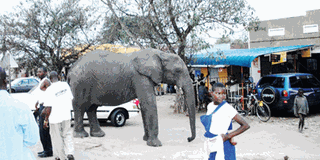Prime
Meet Mary, the elephant who likes to visit town

Mary, the friendly elephant at Katunguru trading centre in Kasese district.
What you need to know:
Over two decades ago, she was orphaned in Queen Elizabeth National Park. Rescued and tamed by park wardens at Mweya Safari Lodge, Mary’s bond with humans is so strong that even though she later returned to the wild, she regularly visits the locals near her abode, writes Felix Basiime.
One evening, I was driving from Fort Portal to Mbarara and as I passed through Katunguru, about 108kms on Mbarara-Fort Portal Road, I could not believe my eyes when I saw a huge elephant comfortably walking around the shops as people gave it food with ease and played with it. I parked my car at a safe distance and fearfully took photos.
“Don’t fear her, this is Mary; there was another one called John, they both used to visit us from the park,” said Birungi, a fish vendor standing nearby.
Mary, an elephant, occasionally visits Katunguru Trading Centre and Kasenyi landing site. She used to move with John till he died some years back. Another elephant, a huge male one called Buruburu , visits the people in Kidepo Valley National Park (KVNP).
Katunguru is a town found in Queen Elizabeth National Park (QENP). Other towns inside QENP include, Muhokya, Katwe-Kabatooro and Kikorongo, but Mary does not go there. Asked to throw some light on the history of Mary and Buruburu, Tom Okello, former Area Chief Warden at QENP said, “Mary was orphaned in QENP some many years ago and park wardens at Mweya Safari Lodge rescued and tamed her. That is why she is so at ease around people. It is the same case with Buruburu in Kidepo.”
He explained that when Mary grew up, her wild nature took over, so she went back to the park but occasionally visits the people because she is used to being around humans, being tame and all. He says the elephants in this case were named by the locals and are as old as two decades.
According to Birungi, Mary lives around Katunguru and Kasenyi landing site but comes to Katunguru at least once a month.
“Her favourite food is matooke and sweet bananas. She comes during the day and spends about an hour and then saunters back to the park,” says Birungi.
Birungi has lived more than eight years at Katunguru and has witnessed most of Mary’s visits. When she visits Katunguru, Mary does not move door to door among the shops, but stands near the roadside, where locals serve her her favourite treats. She even feeds off people’s hands by extending her trunk to pick servings. She is not irritated by people surrounding her and taking her pictures. In fact, locals don’t get nervous in her presence, though strangers get frightened and keep a distance.
“When Mary comes, people here pose for photographs with her but are very careful not to touch her or do anything to irritate her,” said another fish vendor, adding, “After about an hour of attention from us all, she goes back to the park.”
Mary is not the only wild animal that visits Katunguru during the day; warthogs also come around but are not as friendly; instead, they prefer to go the periphery of the town and feed on refuse.
While Mary and Buruburu are friendly, it does not mean that they can’t cause harm.
“People should not be deceived and joke with such animals, they should know that a wild animal, however tame, will turn dangerous at one point,” Okello says.
He also warns tourists not to touch such animals. The elephant is the biggest mammal in the park and the most peaceful, but when irritated it can show its might on any traveller or vehicle passing through the park, according to the park guides at QENP.
According to John Makombo then acting head of the Uganda Wildlife Authority (UWA), the population of elephants, currently estimated at 5,000, has been increasing over the years due to UWA’s strong anti-poaching drives.
“In the 1960s, the elephant population was 30,000, but it kept reducing due to lawlessness that plagued the country in the 1970s and 1980s,” he told the press last year, adding, “Elephants still get wounded when they cross to Sudan and the Democratic Republic of Congo.”
Unfriendly elephants
However, other elephants in QENP destroy people’s crops, especially maize and cotton and during harvest time, people spend sleepless nights around fires near gardens to scare away the wild animals.
Tom Kinyanya, the leader of the Ikongo Farmers Marketing and Cooperative Society, thinks the government has not helped them.
“We have been growing cotton for years but government leaders have given us a deaf ear, which is why they have not responded to our cries when elephants from the Queen Elizabeth national park destroy our crops,” he says.
The farmers want the government to review the UWA policy which prohibits people from killing animals that invade their gardens. They believe that the government values wild animals more than humans.
In 2010, farmers neighbouring the QENP lost about Shs1.8b in crops destroyed by elephants, monkeys and other wild animals, according to a May 2010 report by the Karughe Farmers partnership. UWA has always said the law does not indicate any compensation of the farmers but urges cooperation between the two sides to curb animal invasion of the gardens.
However, Kasese Resident District Commissioner, Capt James Mwesigye, reasons that there is need for co-existence of all the living species on the universe.
Physical characteristics of the African elephant
It is the largest living land mammal. Of all its specialised features, the trunk is perhaps the most extraordinary. It serves as a nose, hand, extra foot, signaling device and tool for gathering food, siphoning water, dusting and digging. The tusks are another notable feature of both males and females. Tusks differ in size, shape and angle and researchers can use them to identify individuals.
Their habitat and behaviours
Elephants can live in nearly any habitat that has adequate quantities of food and water. Their ideal habitat consists of plentiful grass and browse.
Elephants are always associated with permanent water and abundant vegetation (an exception to this is the desert elephant from Namibia, who adapted to the harsh conditions of the area). Because elephants do not have sweat glands, water plays an important role in helping them cool down.
Elephants are very intelligent and highly social animals. They live in herds made up of the matriarch (the oldest female in the group), her female calves and other youngsters. The herd can comprise between six and 30 animals, and even when they split to form new herds, always maintaining contact with each other at water holes and feeding spots.
At 14 years of age, males leave the herd and associate with other bulls of the same age or older. Within the “bull area” hierarchy is well observed and understood by all; when a group of bulls comes across a female in heat, the animal occupying the highest rank is the one to mate.
Males are much larger than females and their tusks are much longer and heavier. They have six sets of molar teeth and when the last set is lost, the animal is unable to feed and eventually dies. Their lifespan is about 50 to 60 years.
Elephants eat practically any vegetable matter - leaves, grass, reeds, roots, flowers, fruits, bark and even soil if the mineral content is high. They eat about 250Kg of food and drink about 150 to 200 litres of water a day.
Females are sexually mature at 12 years of age and are mated by visiting bulls. After a gestation period of 22 months, a cow (female) gives birth to a single calf weighting up to 130Kg. The calf suckles for about three years.
Questions about elephants
Do people still ride elephants in India?
Yes they do, for various occasions, such as temple ceremonies. Former timber camp elephants are now used as safari riding elephants instead, taking people for rides in protected forests that previously were harvested teak forests.
How fast can elephants run?
Some old records say around 30 km per hour. Some experts say that no human being can run faster than an attacking elephant.
They change from fast walking to “jump-running”, where at least one foot is left on the ground.
How much can an elephant lift?
With its trunk, an elephant can lift about 200-400kgs, depending on the size of the elephant. In QENP, elephants have uprooted some middle sized trees.




